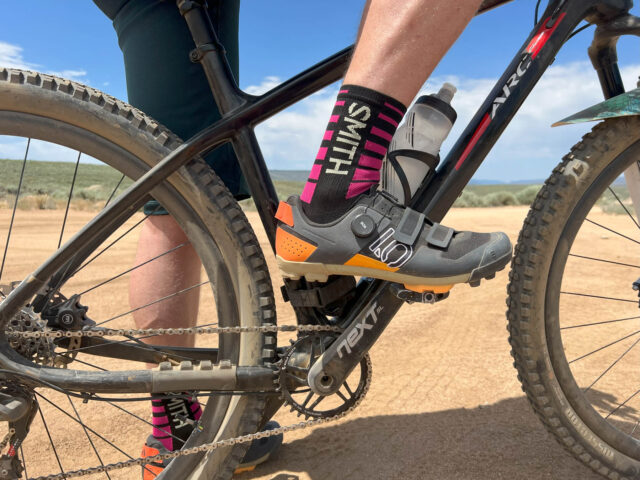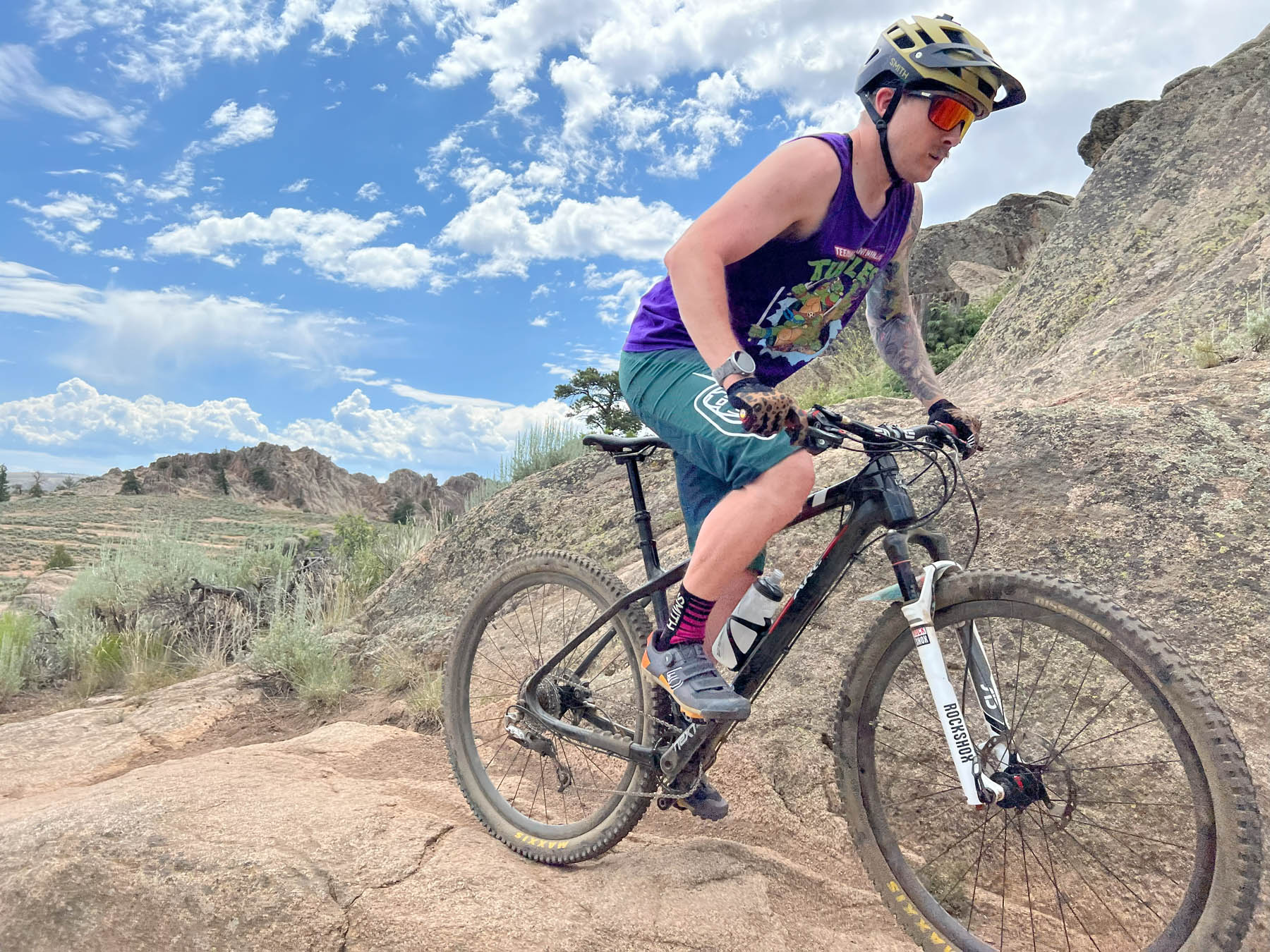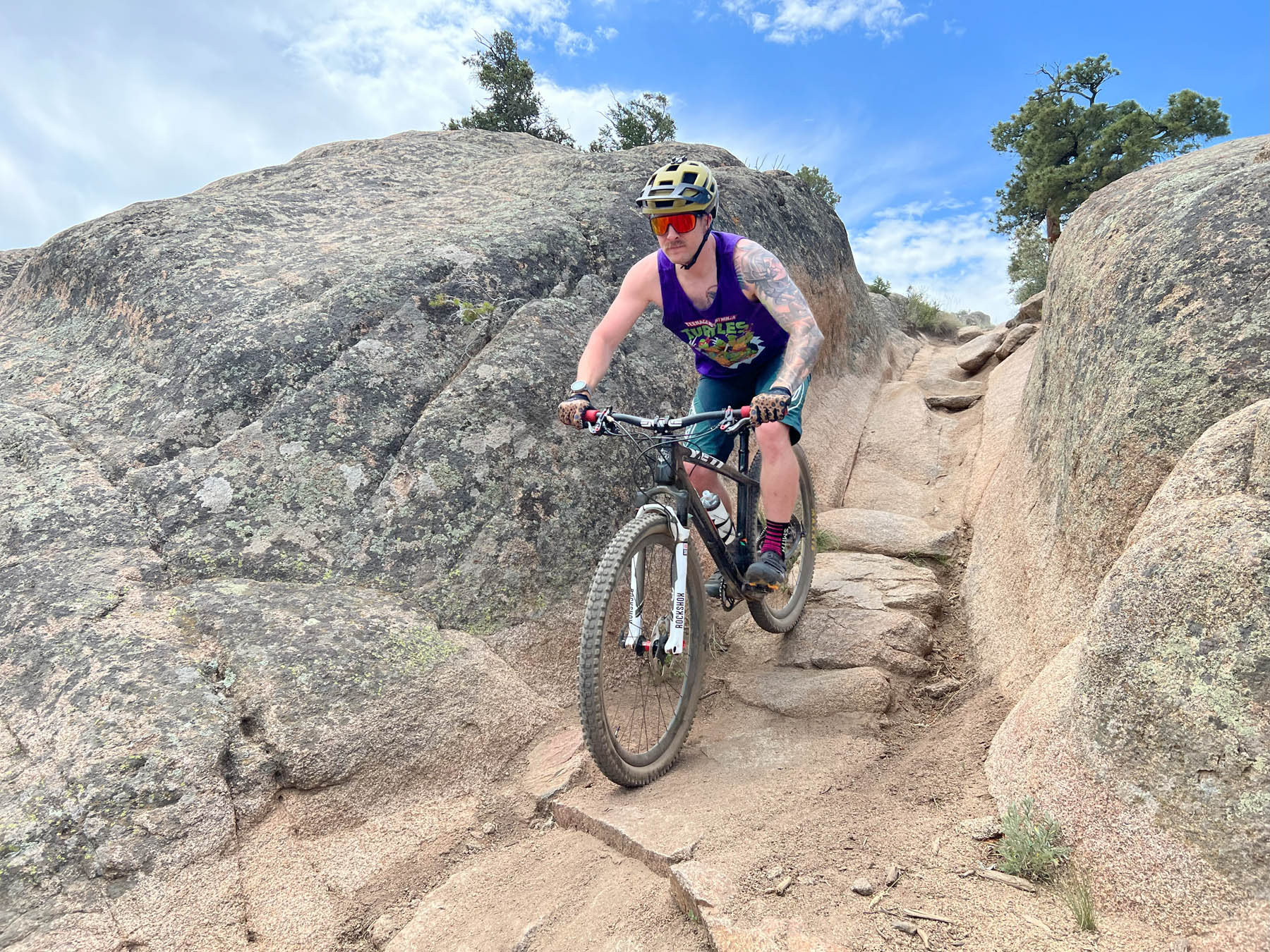Five Ten Kestrel Boa
Reviewer: 5’9”, 170 lbs / 175 cm, 77.1 kg
Size Tested: US 10.5
Blister’s Measured Weight Per Shoe: 400 and 400 g
Pedals Used: Crank Brothers Candy, Crank Brothers Mallet E
Stated Features:
- Micro-adjustable dial-based Boa® Fit System plus hook-and-loop straps
- Synthetic upper with seamless overlays
- Non-slip heel cup
- Clipless shank
- Impact-resistant toe box
- Stealth Marathon rubber outsole
- Upper contains a minimum of 50% recycled content
MSRP: $230
Test Location: Gunnison Valley, CO
Test Duration: ~3 months

Intro
The Kestrel Boa is a new XC / Trail bike shoe from Five Ten, which is designed to pair XC performance with the gravity DNA Five Ten is best known for. As modern Trail bikes and their use continue to evolve, the Kestrel Boa steps away from some of the classic XC shoe design elements in an effort to create something that works for riders who don’t need or want a more gravity-influenced Enduro-style shoe, while improving comfort and off-bike useability relative to something designed to excel as an XC race tool. So how has Five Ten gone about that, and how do the results pan out on the trail?

Design and Features
The Five Ten Kestrel Boa shares much of the familiar Five Ten DNA, including some classic Five Ten Stealth Rubber (or at least a patch of it). A full-length plate made in part with recycled materials and reinforced with glass fiber provides excellent power transfer with added pedal stability, while a recessed cleat design connects your shoe to the pedal for improved efficiency and power transfer. The sole uses a Stealth Marathon rubber compound and includes additional (and aggressive) lugs in the toe and heel to aid in walking traction. The Kestrel Boa is a lightweight and breathable shoe, designed to prioritize all-day wearable comfort, and utilizes a Micro-adjustable dial-style Boa Fit System over the instep plus hook-and-loop straps for added security and to reduce heel lift when putting the power down.
Despite the similar name to the prior-generation Kestrel Pro Boa, the new Kestrel Boa is a very different shoe. The Kestrel Pro Boa is a heavier shoe, with a bigger footprint (literally), a taller heel cup, a thicker midsole, a less breathable but more protective upper, and a Stealth rubber sole with minimal tread for maximum contact with wider-platform pedals. Overall, it’s a much more enduro/DH-oriented design that prioritizes stability and control on the descent.
Weight
Perhaps unsurprisingly, given their design and intentions, the Kestrel Boas are pretty light for a clipless MTB Trail shoe. Not so much when compared to XC-race-oriented shoes, but that’s not the benchmark here. Our measured weights for a bunch of Trail and Gravity-oriented options are below, for reference — and, as always, pay attention to differences in relative sizing.
- Five Ten Kestrel Boa: 400 g (size 44)
- Pearl Izumi X-Alp Launch: 406 g (size 43.5)
- Five Ten Trailcross Clip-In (size 10): 416 and 423 g
- Shimano ME7: 423 g (size 44)
- Specialized 2FO DH Clip: 428 and 434 g (size 44)
- Shimano AM901: 439 and 443 g (size 44)
- Shimano AM903: 464 and 466 g (size 44)
- Endura MT500 Burner: 476 and 476 g (size 43)
- Five Ten Kestrel Pro Boa: 456 g (size 9.5)
- Ion Rascal Amp: 493 and 508 g (size 44)
- Ride Concepts Tallac: 538 and 539 g (size 10)
- Leatt 5.0: 535 and 542 g (size 10)
- Five Ten Hellcat Pro: 546 g (Size 9.5)
- Ride Concepts Transition: 556 and 558 g (size 10)
Sizing and Fit
For US sizing, Five Ten offers the men’s Kestrel Boa from size 6 to 14, with half sizes up to a size 13, and in a women’s version with half sizes from 5.5 to 11.
Most of the XC shoes I have put my foot into over the years tended to have a very low-volume fit and minimal padding or cushioning, in an effort to maximize power transfer and minimize weight. The Kestrel Boa strikes more of a middle ground here, which aligns well with its intended use. A generous toe box, padding around the ankle, and midsole which is stiff without being punishing all make this an easy shoe to fit into and to wear. The Boa closure over the instep does a great job of keeping my heel locked in, the “tongue” (overlay) is comfortable and without pressure points, the upper is breathable while feeling sturdy, and the toe box cap is robust to help protect against rock strikes or impacts. But the overall package is still low profile and generally svelte, especially if you are coming from a more gravity-oriented shoe.
Performance
The burlier Five Ren Kestrel Pro Boa is in my own personal “quiver” of bike shoes, and one I find I reach for about seventy percent of the time. I was interested to see how the new Kestrel Boa mixed things up, as they no longer make the Kestrel Pro Boa. In profile, the Kestrel Boa physically looks like a “classic” XC shoe. The upper is low profile with aggressive lugs on the sole for walking.
The sole of the Kestrel Boa uses Five Ten’s Stealth Marathon Rubber, which is designed to wear longer and better than the softer and gripper versions of Stealth Rubber used in their flat-pedal shoes. And while I wouldn’t say this is the ideal choice of footwear if you are going to be doing a ton of hike-a-biking every ride, if you have experience walking in hard-soled XC or road bike shoes, the Kestel Boa’s grip, energy absorption, and comfort while walking on hard surfaces immediately stand out. The toe and heel pillars do a good job of creating traction, and I don’t miss feeling like I have football cleats on when walking on hard surfaces. The cleat channel itself is quite deep, but also narrow. This helps the tread of the shoe sit as flush as possible with the pedal face to improve energy transfer and feel, but it does make finding your pedal/cleat clip-in point a bit more finicky.

When riding, you can feel that the shank of the shoe is a bit softer than a true XC race shoe, but stiffer and a narrower platform than an Enduro or DH one. The flex pattern feels supportive and efficient when driving energy through the pedal but doesn’t feel harsh when your heels are dropped and you are pointed downhill. I noticed the lack of ankle support more than the flex of the shank of the shoe when descending, to be honest. The wider toe box (than the Five Ten and Pearl Izumi shoes that I normally wear) does also allow more movement from the front of your foot, which makes it feel like less of a performance fit in the front half of this shoe. But that same trait is welcome when hiking or just spending a long day in the Kestrel Boa. The softer sole (relative to more XC-specific models) helps avoid that awkward heel-first rolling step I find myself often adopting in shoes with a stiffer sole, and the wider toe box gives your feet (toes) a bit of room to spread apart and increases stability when walking.

I found the Kestrel Boa to not be a great pairing with larger-platform clipless pedals. The shoe’s narrower contact point underfoot, low-cut ankle, and stiffer shank all meant that this is a shoe that rewards user-provided ankle stability, and a wider platformed pedal didn’t really offer more of this with a smaller contact patch sitting on top of it. Smaller-bodied pedals also made it easier to clip in and out, with the tall lugs of the shoe making the smaller pedal easier to find underfoot.
As for other features go: I had no problem with the lower velcro closures of the Kestrel Boa, but wouldn’t have been mad if they had used two Boa closures, instead. The upper material dries out reasonably quickly if you get your feet wet, and the rubberized toe cap never left my toes feeling vulnerable and generally, my foot felt well protected.
Compared to the prior-generation Kestrel Boa Pro, the new Kestrel Boa is a much more XC-oriented shoe. The Pro is (or was) simply a more descent-focused piece of kit that sacrificed weight and breathability for stability and protection. Fundamentally, these are two different shoes with different intended uses, and despite very similar naming, the new Kestrel Boa is not a direct replacement for the Kestrel Boa Pro. The new Kestrel Boa is closer to an XC shoe than it is to a DH shoe, whereas the Kestrel Boa Pro was closer to a DH shoe than it was an XC shoe.

Durability
After roughly 150 miles, the Kestrel Boa is holding up great. I have rubbed a bit of the orange off (and onto my chain strays), the soles show some wear, and the velcro isn’t quite as fresh as it once was, but there’s no lost stitching, delaminating velcro, stripped-out cleat hardware, or anything else of note. They are performing as expected, and I haven’t cracked the midsole of the shoe from overuse or flex (as I have done several times with stiffer/carbon midsoled shoes). If I run into any abnormal durability issues down the line, I’ll update this section. I have had good luck with Boa closures over the years, and have this time as well. I have only ever worn out the mechanism, never broken it. In that instance, you can email Boa and they will promptly get some replacement parts headed your way if it’s something you are stressed about.
Bottom Line
The Five Ten Kestral Boa is a comfortable, easy-to-wear, ride-in, walk-in, and (I suspect for most folks) an easy-to-fit-into shoe for many who are simply looking for a versatile clipless MTB shoe for all-around use. If you are looking for a “comfortable” XC or Trail performance shoe, this is an easy one to recommend. The Kestral Boa is a good choice for trail rides where walking, putting down watts, and long descents are all on the menu on any given ride.
The Kestrel Boa is designed as a more versatile XC / Trail shoe, and it doesn’t have the ultra-stiff and responsive feel of a lightweight XC shoe. Conversely, if you ride pedals with a larger platform and prioritize compliance and impact absorption or protection, it will be a bit stiff and transmit more trail noise than you would find in a heavier Enduro shoe. But if your bike, terrain, or rides reflect that middle fifty percent of circumstances and conditions, the Kestrel Boa just might be the right tool for most days. I have really enjoyed my time with this shoe, and have appreciated the more versatile spin on a classic XC mountain bike shoe. Ultimately, the Five Ten Kestrel Boa won’t replace the old Kestrel Pro Boa as my go-to Enduro footwear, but rather, it feels like a refinement of the very classic formula of the XC MTB shoe.

Thanks for the excellent review! I have a pair on the way and your words confirm my expectations. My current go to shoe is the Giro Chamber II because of its comfort and dampening and big volume fit, but it is a little flexy, so this may be a good compromise that eels out more ventilation and efficiency. Appreciate the time you took to write it!